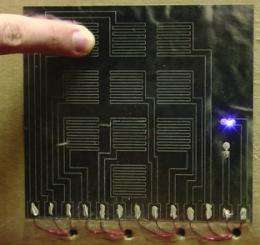A paper-based touch pad on an alarmed cardboard box detects the change in capacitance associated with the touch of a finger to one of its buttons. The keypad requires the appropriate sequence of touches to disarm the system. Image credit: Mazzeo, et al.
(Phys.org) -- Today, electronic touch pads are widely found on laptops, tablets, and other computing devices. Less common uses, but gaining in popularity, are book covers and food labels. These and other low-tech applications become possible as touch pads become extremely inexpensive, with applications ranging from beer bottle labels to disposable medical device labels. Now a team of researchers from the US and France have developed paper-based electronic touch pads that cost just 25 cents per square meter, a price at which touch pads can simply be thrown away when no longer needed.
The touch pads are made of metallized paper, which is paper coated in aluminum and transparent polymer. The paper can function as a capacitor, and a laser can be used to cut several individual capacitors in the paper, each corresponding to a key on the touch pad. When a person touches a key, the key’s capacitance is increased. Once the keys are linked to external circuitry and a power source, the system can detect when a key is touched by detecting the increased capacitance.
According to lead researcher Aaron Mazzeo of Harvard University, the next steps will be finding a power source and electronics that are cheap, flexible, and disposable.
Among the applications, inexpensive touch pads could be used for security purposes. The researchers have already developed a box with an alarm and keypad that requires a code to allow authorized access. Disposable touch pads could also be useful in sterile or contaminated medical environments.
More information:
Aaron Mazzeo, et al. "Paper-Based, Capacitive Touch Pads." DOI: 10.1002/adma.201200137
via: Chemistry World
© 2012 Phys.Org






















